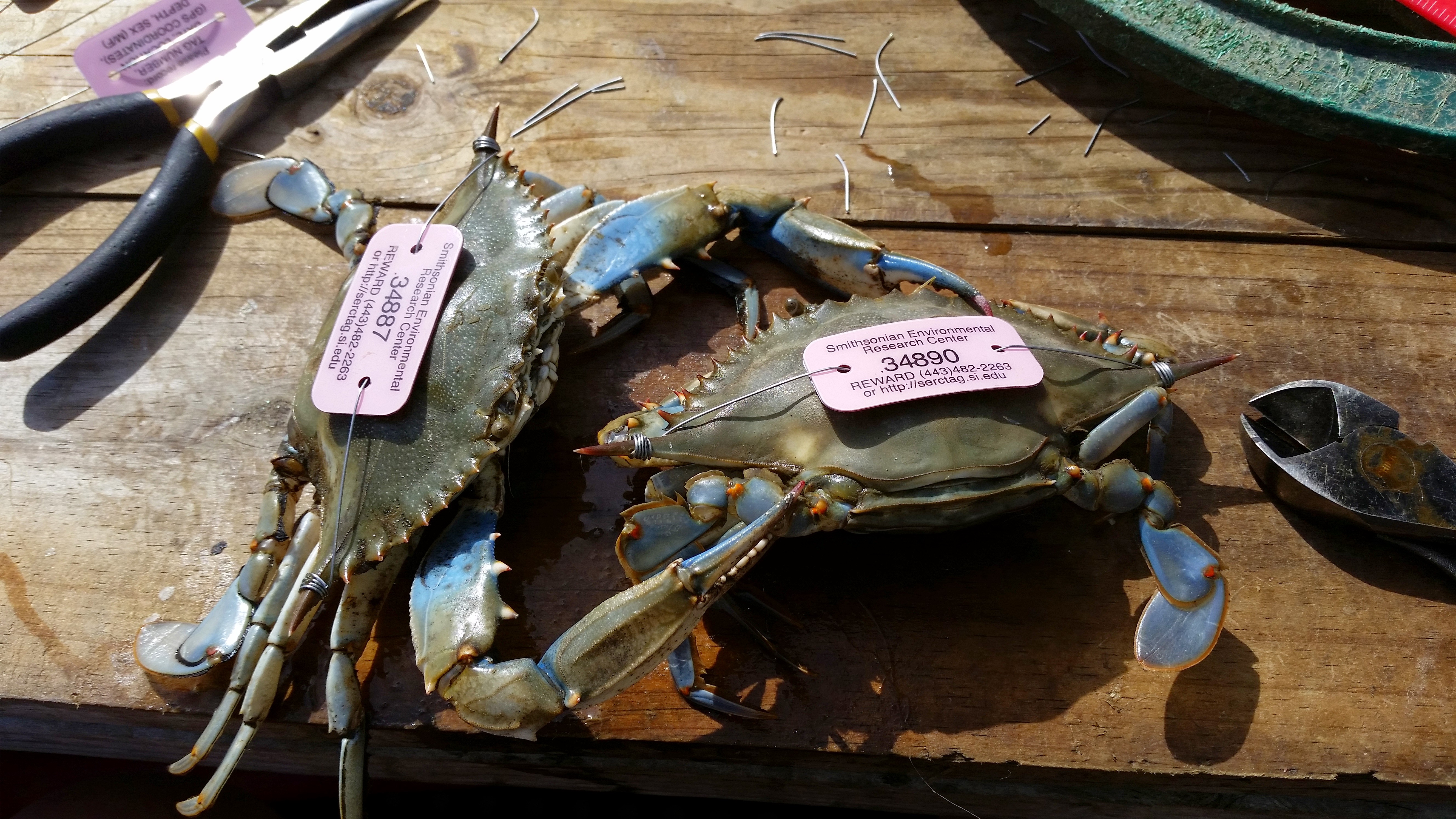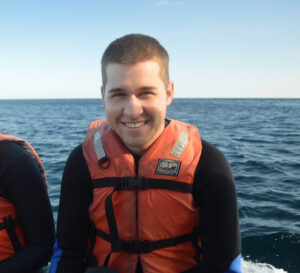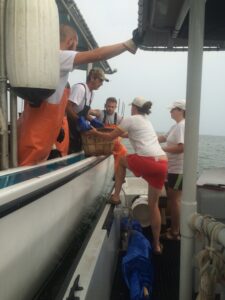by Kristen Minogue

Biologists outfitted crabs with these pink tags, offering a reward to crabbers who found them and reported the catch. (Credit: Kim Richie/SERC)
When it comes to recreational crabbing—one of the most iconic pastimes along Maryland’s shores—the current estimate of 8% of “total male commercial harvest” runs just a little too low. Biologists, with local community support, found stronger evidence for the underestimate in the first tagging study to estimate the recreational blue crab harvest statewide.
“It’s such an important cultural activity here to go out and harvest crabs,” said Matt Ogburn, a biologist with the Smithsonian Environmental Research Center (SERC) and co-author of the new report. After years of record low numbers, the government declared the crabs a “commercial fishery failure” in 2008. But over the past decade, the crabs have made a bumpy but steady comeback.
To keep that recovery going, managers need a clear idea of how many crabs end up in commercial traps and on the tables of recreational crabbers. Commercial crabbers must report how many crabs they catch each season. But recreational crabbers have no such obligation. This leaves managers in the awkward position of having to make their best educated guess.

Robert Semmler, a Lancaster University Ph.D. student, teamed up with the Smithsonian and local crabbers in the first statewide tagging survey to estimate recreational crabbing in Maryland.(Credit: Isidro Bosch)
“The recreational fishery is a bit of an unknown,” said Robert Semmler, a doctoral student at Lancaster University and lead author of the new study, published March 15 in The Canadian Journal of Fisheries and Aquatic Sciences. “And a lot of people are concerned about the recreational fishery. Particularly within the commercial sector, fishers are concerned about how big the recreational fishery is and whether that is possibly impinging on their ability to fish themselves.”
Tag, Release, Reward
Right now, the Chesapeake Bay Stock Assessment Committee estimates recreational harvest to be 8% of the total male commercial harvest. Since recreational crabbers can’t harvest females—a 2008 rule to protect spawning—comparing “total male” harvests should offer a better apples-to-apples comparison.
But the 8% figure has its skeptics. To get it, managers relied on surveys and voluntary self-reports from recreational crabbers in 2001, 2002, 2005 and 2011. Those surveys suggested recreational crabbing amounted to 5–8% of the total commercial harvest. Some of those surveys suggested a higher figure—11.6%—of the total male commercial harvest. For managers, estimating recreational crabbing as “8% of total male commercial harvest” seemed like a happy medium. Even so, some people recall seeing far more recreational crabbing in certain parts of the Chesapeake Bay.
“If those methods underestimated the amount of recreational fishing, if we keep doing the same thing, we’ll always be underestimating it, and we won’t know that,” Ogburn said.
So Ogburn, Semmler and SERC’s Fisheries Conservation Lab decided it was time to try a new method to see if the 8% figure would hold up. The project was part of Semmler’s master’s thesis during his time at the University of Maryland.

SERC biologists Keira Heggie (red shorts) and Kim Richie work with local watermen to tag and release crabs into the Chesapeake Bay. (Credit: Fisheries Conservation Lab/SERC)
The biologists used a technique called mark-recapture. They teamed up with local watermen to mark 6,800 crabs with vinyl tags on their shells. Their tagging effort spanned 15 regions along Maryland’s eastern and western shores, including the bay mainstem and several tributaries. The vast scope gave them a thorough picture of crabbing statewide.
The tags contained the lab’s phone number and an offer for a reward. Anyone who captured a tagged crab could call the number, tell the scientists where they caught the crab and if they were a commercial or recreational crabber.
The assist from the local community was critical. Rob Aguilar, head technician for the Fisheries Conservation Lab, helped find crabbers to let scientists tag crabs on their boats. But success truly hinged on having enough crabbers willing to call in their catches.
“It’s good to have that relationship and to have people in the community know that they can trust the science, because they were involved in it,” Semmler said.
From there, it became a simple algebra problem. Once the scientists had three variables—total commercial harvest, number of commercial captures called in and number of recreational captures called in—they could plug them in to find the number they really wanted: total recreational harvest.
Moving Targets
However, the team didn’t stop there. They took things a step further to account for crabs moving throughout the bay. Blue crabs don’t stay in one place. They move between the saltier bay mainstem—where commercial crabbing prevails—and fresher tributaries, where recreational crabbing is more common. Ignoring crab movement could easily skew the team’s estimates.
Once they took that into account, their results changed. Without crab movement, the team calculated recreational harvest at 4.04 million crabs. That’s roughly 8.4% of “total male” commercial harvest—right in line with the current 8% estimate. But with crab movement in the equation, recreational harvest rose to 5.39 million crabs—or 11.2% of “total male” commercial harvest.
Shifting to an 11.2% estimate, the authors say, would give Maryland a more accurate picture of recreational crabbing. It would also be closer to the average of 11.6% of “total male” commercial harvest, derived from previous surveys.
By tagging in over a dozen regions, the lab also pinned down spots where recreational harvest is higher than average. Hot spots of recreational crabbing tended to be in tributaries with waterfront homes and easy boating access.
“Depending on where you live, recreational harvest could range from near zero to more than twice the size of commercial harvest in densely populated places like the Severn River,” Ogburn said. “That means you might see high recreational harvest of crabs in your local area, but once you average across the entire state, the level of harvest isn’t much higher than expected.”
Scientists from the Smithsonian Environmental Research Center, Lancaster University and the University of Maryland took part in the project. The full study is available online at https://cdnsciencepub.com/doi/full/10.1139/cjfas-2020-0112.

